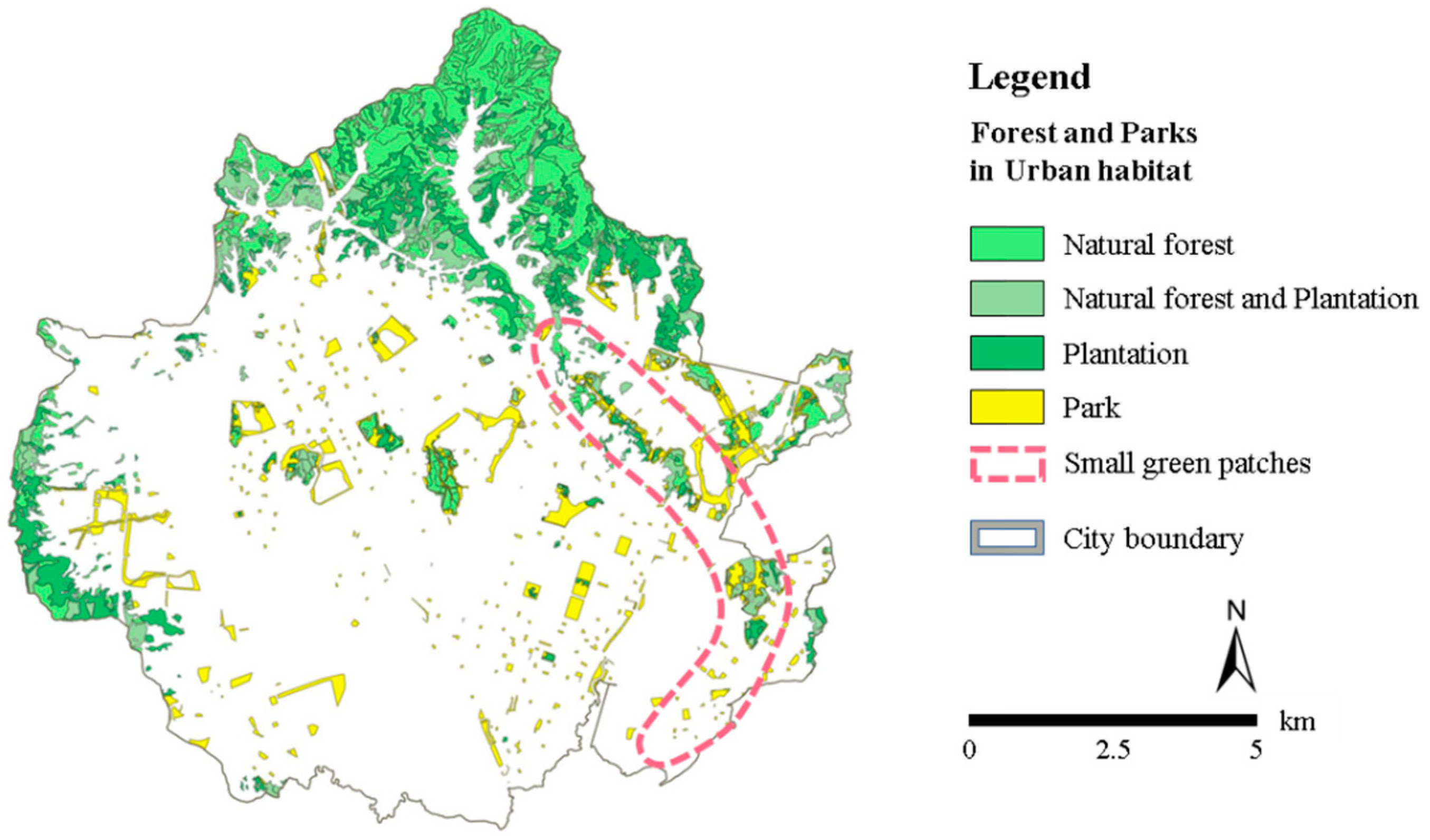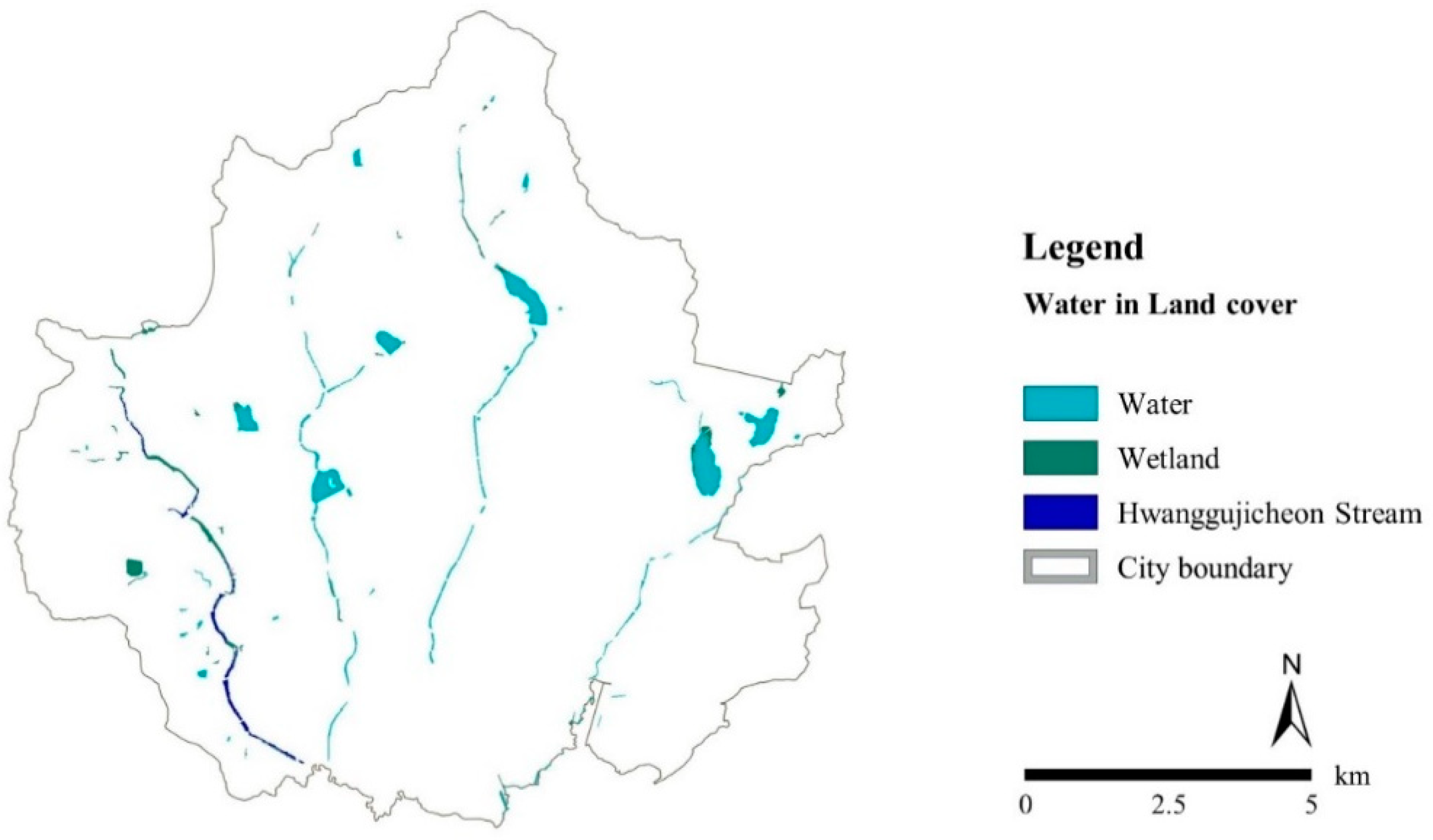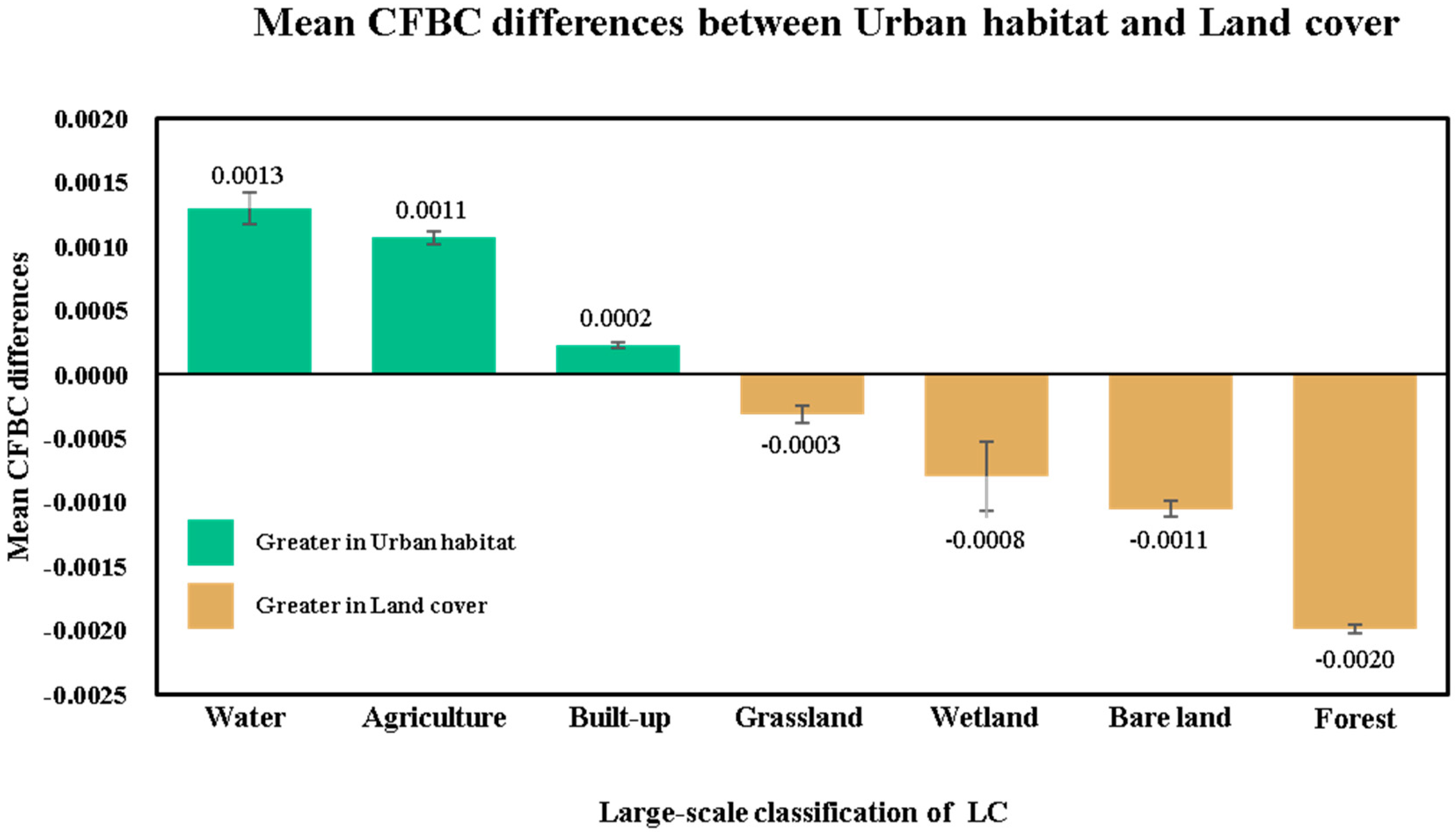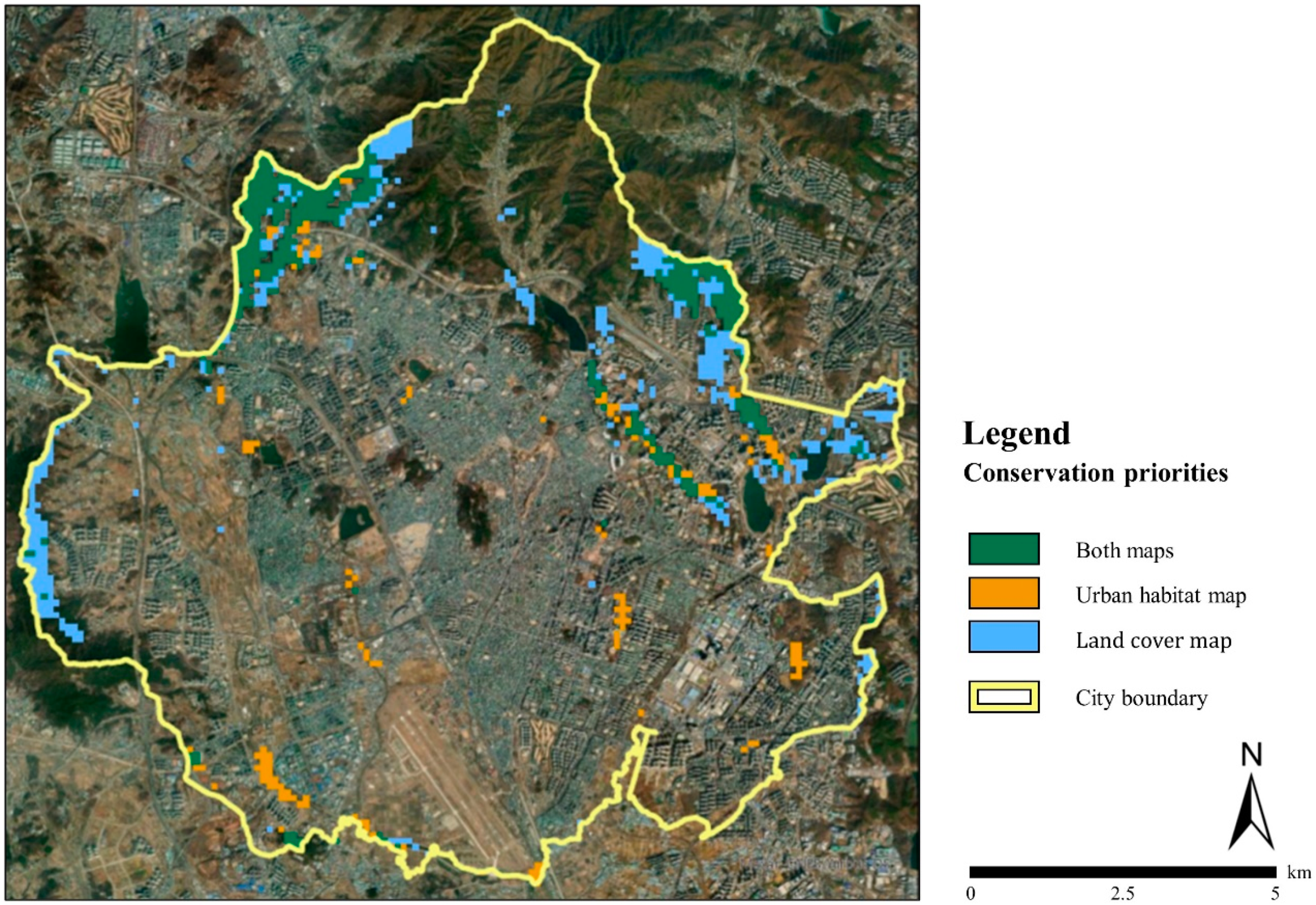Estimation of Ecological Connectivity in a City Based on Land Cover and Urban Habitat Maps
Abstract
1. Introduction
2. Materials and Methods
2.1. Study Area and Datasets
2.2. Connectivity Analysis
2.3. Generating Permeability Maps
3. Results
3.1. Current-Flow Betweenness Centrality Results Derived from Land Cover and Urban Habitat Maps
3.2. Differences between the Current-Flow Betweenness Centrality Maps
4. Discussion
4.1. Land Cover Map and Urban Habitat Map for the Connectivity Analysis
4.2. Contribution to Connectivity
4.3. Conservation-Priority Areas
5. Conclusions
Author Contributions
Funding
Acknowledgments
Conflicts of Interest
Appendix A

Appendix B

References
- Butchart, S.H.M.; Walpole, M.; Collen, B.; Van Strien, A.; Scharlemann, J.P.W.; Almond, R.E.A.; Baillie, J.E.M.; Bomhard, B.; Brown, C.; Bruno, J.; et al. Global biodiversity: Indicators of recent declines. Science 2010, 328, 1164–1168. [Google Scholar] [CrossRef]
- Foley, J.A.; DeFries, R.; Asner, G.P.; Barford, C.; Bonan, G.; Carpenter, S.R.; Chapin, F.S.; Coe, M.T.; Daily, G.C.; Gibbs, H.K.; et al. Global consequences of land use. Science 2005, 309, 570–574. [Google Scholar] [CrossRef] [PubMed]
- Theobald, D.M.; Reed, S.E.; Fields, K.; Soulé, M. Connecting natural landscapes using a landscape permeability model to prioritize conservation activities in the United States. Conserv. Lett. 2012, 5, 123–133. [Google Scholar] [CrossRef]
- Arroyo-Rodríguez, V.; Melo, F.P.; Martínez-Ramos, M.; Bongers, F.; Chazdon, R.L.; Meave, J.A.; Norden, N.; Santos, B.A.; Leal, I.R.; Tabarelli, M. Multiple successional pathways in human-modified tropical landscapes: New insights from forest succession, forest fragmentation and landscape ecology research. Biol. Rev. 2017, 92, 326–340. [Google Scholar] [CrossRef]
- Lindenmayer, D.B.; Fischer, J. Habitat Fragmentation and Landscape Change: An Ecological and Conservation Synthesis. Retrieved 16 September 2020; Island Press: Washington, DC, USA, 2016. [Google Scholar]
- United Nations, Department of Economic and Social Affairs, P.D. World Urbanization Prospects The 2014 Revision Methodology; UN: New York, NY, USA, 2014. [Google Scholar]
- Cui, N.; Feng, C.-C.; Wang, D.; Li, J.; Guo, L. The Effects of Rapid Urbanization on Forest Landscape Connectivity in Zhuhai City, China. Sustainability 2018, 10, 3381. [Google Scholar] [CrossRef]
- Savard, J.P.L.; Clergeau, P.; Mennechez, G. Biodiversity concepts and urban ecosystems. Landsc. Urban Plan. 2000, 48, 131–142. [Google Scholar] [CrossRef]
- Serret, H.; Raymond, R.; Foltête, J.C.; Clergeau, P.; Simon, L.; Machon, N. Potential contributions of green spaces at business sites to the ecological network in an urban agglomeration: The case of the Ile-de-France region, France. Landsc. Urban Plan. 2014, 131, 27–35. [Google Scholar] [CrossRef]
- Tischendorf, L.; Fahrig, L. On the usage and measurement of landscape connectivity. Oikos 2000, 90, 7–19. [Google Scholar] [CrossRef]
- Goodwin, B.J. Is landscape connectivity a dependent or independent variable? Landsc. Ecol. 2003, 18, 687–699. [Google Scholar] [CrossRef]
- Reddingius, J.; Den Boer, P.J. Simulation experiments illustrating stabilization of animal numbers by spreading of risk. Oecologia 1970, 5, 240–284. [Google Scholar] [CrossRef]
- Wegner, J.F.; Merriam, G. Movements by birds and small mammals between a wood and adjoining farmland habitats. J. Appl. Ecol. 1979, 16, 349–357. [Google Scholar] [CrossRef]
- Liro, A.; Szacki, J. Movements of field mice Apodemus ngrarius (Pallas) in a suburban mosaic of habitats. Oecologia 1987, 74, 438–440. [Google Scholar] [CrossRef] [PubMed]
- Potter, M.A. Movement of North Island brown kiwi (Apteryx australis mantelli) between forest remnants. N. Z. J. Ecol. 1990, 14, 17–24. [Google Scholar]
- Szacki, J.; Liro, A. Movements of small mammals in the heterogeneous landscape. Landsc. Ecol. 1991, 5, 219–224. [Google Scholar] [CrossRef]
- Johnson, A.R.; Milne, B.T.; Wiens, J.A.; Crist, T.O. Animal movements and population dynamics in heterogeneous landscapes. Landsc. Ecol. 1992, 7, 63–75. [Google Scholar] [CrossRef]
- Hobbs, R.J. The role of corridors in conservation: Solution or bandwagon? Trends Ecol. Evol. 1992, 7, 389–392. [Google Scholar] [CrossRef]
- Garcia-Lozano, C.; Varga, D.; Pintó, J.; Roig-Munar, F.X. Landscape Connectivity and Suitable Habitat Analysis for Wolves (Canis lupus L.) in the Eastern Pyrenees. Sustainability 2020, 12, 5762. [Google Scholar] [CrossRef]
- Worboys, G.L.; Pulsford, I. Connectivity conservation in Australian landscapes. In Report Prepared for the Australian Government Department of Sustainability, Environment, Water, Population and Communities on behalf of the State of the Environment; Australian Government Publishing Services: Canberra, Australia, 2011. [Google Scholar]
- Hilty, J.A.; Lidicker, W.Z., Jr.; Merenlender, A.M. Corridor Ecology: The Science and Practice of Linking Landscapes for Biodiversity Conservation; Island Press: Washington, DC, USA, 2012. [Google Scholar]
- Bélisle, M. Measuring landscape connectivity: The challenge of behavioral landscape ecology. Ecology 2005, 86, 1988–1995. [Google Scholar] [CrossRef]
- Baguette, M.; Van Dyck, H. Landscape connectivity and animal behavior: Functional grain as a key determinant for dispersal. Landsc. Ecol. 2007, 22, 1117–1129. [Google Scholar] [CrossRef]
- Metzger, J.P.; Decamps, H. The structural connectivity threshold: An hyphothesis in conservation biology at the landscape scale. Acta Oecol. 1997, 18, 1–12. [Google Scholar] [CrossRef]
- Walker, R.; Craighead, L. Analyzing wildlife movement corridors in Montana using GIS. In Proceedings of the 1997 ESRI User Conference, Redlands, CA, USA, 8–11 July 1997. [Google Scholar]
- Beier, P.; Majka, D.R.; Spencer, W.D. Forks in the road: Choices in procedures for designing wildland linkages. Conserv. Biol. 2008, 22, 836–851. [Google Scholar] [CrossRef] [PubMed]
- Pinto, N.; Keitt, T.H. Beyond the least-cost path: Evaluating corridor redundancy using a graph-theoretic approach. Landsc. Ecol. 2009, 24, 253–266. [Google Scholar] [CrossRef]
- Singleton, P.H. Landscape Permeability for Large Carnivores in Washington: A Geographic Information System Weighted-Distance and Least-Cost Corridor Assessment; US Department of Agriculture, Forest Service, Pacific Northwest Research Station: Portland, OR, USA, 2002.
- Rayfield, B.; Fortin, M.J.; Fall, A. Connectivity for conservation: A framework to classify network measures. Ecology 2011, 92, 847–858. [Google Scholar] [CrossRef] [PubMed]
- Vanthomme, H.P.A.; Nzamba, B.S.; Alonso, A.; Todd, A.F. Empirical selection between least-cost and current-flow designs for establishing wildlife corridors in Gabon. Conserv. Biol. 2019, 33, 329–338. [Google Scholar] [CrossRef] [PubMed]
- Adriaensen, F.; Chardon, J.P.; De Blust, G.; Swinnen, E.; Villalba, S.; Gulinck, H.; Matthysen, E. The application of “least-cost” modelling as a functional landscape model. Landsc. Urban Plan. 2003, 64, 233–247. [Google Scholar] [CrossRef]
- McRae, B.H.; Dickson, B.G.; Keitt, T.H.; Shah, V.B. Using circuit theory to model connectivity in ecology, evolution, and conservation. Ecology 2008, 89, 2712–2724. [Google Scholar] [CrossRef]
- Carvalho, F.; Carvalho, R.; Mira, A.; Beja, P. Assessing landscape functional connectivity in a forest carnivore using path selection functions. Landsc. Ecol. 2016, 31, 1021–1036. [Google Scholar] [CrossRef]
- Cushman, S.A.; Lewis, J.S.; Landguth, E.L. Evaluating the intersection of a regional wildlife connectivity network with highways. Mov. Ecol. 2013, 1, 1–11. [Google Scholar] [CrossRef]
- LaPoint, S.; Balkenhol, N.; Hale, J.; Sadler, J.; van der Ree, R. Ecological connectivity research in urban areas. Funct. Ecol. 2015, 29, 868–878. [Google Scholar] [CrossRef]
- Pullinger, M.G.; Johnson, C.J. Maintaining or restoring connectivity of modified landscapes: Evaluating the least-cost path model with multiple sources of ecological information. Landsc. Ecol. 2010, 25, 1547–1560. [Google Scholar] [CrossRef]
- Chetkiewicz, C.-L.B.; Cassady, C.; Clair, S.; Boyce, M.S. Corridors for Conservation: Integrating Pattern and Process. Annu. Rev. Org. 2006, 37, 317–342. [Google Scholar] [CrossRef]
- Choi, H.; Lee, J.; Sohn, H.; Cho, D.; Song, Y. Feasibility of Green Network in a Highly-dense Urbanized Area by Introducing Urban Gardens. Korean J. Environ. Ecol. 2017, 31, 252–265. [Google Scholar] [CrossRef]
- Rusciano, V.; Civero, G.; Scarpato, D. Urban gardens in the city of naples: An empirical analysis. Calitatea 2018, 19, 436–442. [Google Scholar]
- Hong, S.H.; Han, B.H.; Choi, S.H.; Sung, C.Y.; Lee, K.J. Planning an ecological network using the predicted movement paths of urban birds. Landsc. Ecol. Eng. 2013, 9, 165–174. [Google Scholar] [CrossRef]
- Sung, H.C.; Kim, M.R.; Hwang, S.Y.; Kim, S.R. A Basic Study on Connectivity of Urban Parks for the Urban Ecological Network Establishment. J. Korean Soc. Environ. Restor. Technol. 2014, 17, 125–136. [Google Scholar] [CrossRef]
- Park, S.C.; Han, B.H.; Park, M.J.; Yun, H.; Kim, M. A Study on the Possibility of Utilizing Both Biotope Maps and Land Cover Maps on the Calculation of the Ecological Network Indicator of City Biodiversity Index. J. Korean Inst. Landsc. Archit. 2016, 44, 73–83. [Google Scholar] [CrossRef][Green Version]
- Kim, H.S.; Jang, N.R. Current Issues and Alternatives of Urban Habitat Map in Gyeonggi Province; Gyeonggi Research Institute, Ecology & Environment Lab: Suwon, Korea, 2019. [Google Scholar]
- Kang, W.M.; Song, Y.K.; Sung, H.C.; Lee, D.K. Assessing conservation priorities of unexecuted urban parks in Seoul using ecological network and accessibility analyses. J. Korean Soc. Environ. Restor. Technol. 2018, 21, 53–64. [Google Scholar] [CrossRef]
- Carroll, C.; Mcrae, B.H.; Brookes, A. Use of Linkage Mapping and Centrality Analysis Across Habitat Gradients to Conserve Connectivity of Gray Wolf Populations in Western North America. Conserv. Biol. 2012, 26, 78–87. [Google Scholar] [CrossRef]
- Birch, C.P.D.; Oom, S.P.; Beecham, J.A. Rectangular and hexagonal grids used for observation, experiment and simulation in ecology. Ecol. Model. 2007, 206, 347–359. [Google Scholar] [CrossRef]
- Rusche, K.; Reimer, M.; Stichmann, R. Mapping and assessing green infrastructure connectivity in European city regions. Sustainability 2019, 11, 1819. [Google Scholar] [CrossRef]
- Kyle McKay, S.; Schramski, J.R.; Conyngham, J.N.; Craig Fischenich, J. Assessing upstream fish passage connectivity with network analysis. Ecol. Appl. 2013, 23, 1396–1409. [Google Scholar] [CrossRef]
- Clucas, B.; Parker, I.D.; Feldpausch-Parker, A.M. A systematic review of the relationship between urban agriculture and biodiversity. Urban Ecosyst. 2018, 21, 635–643. [Google Scholar] [CrossRef]
- Song, W.K. Habitat Analysis of Hyla suweonensis in the Breeding Season Using Species Distribution Modeling. J. Korea Soc. Environ. Restor. Technol. 2015, 18, 71–82. [Google Scholar] [CrossRef][Green Version]
- Rusciano, V.; Scarpato, D.; Civero, G. Territorial Social Responsibility: A Cluster Analysis on a case study. Calitatea 2019, 20, 543–548. [Google Scholar]
- Rusciano, V.; Civero, G.; Scarpato, D. Urban gardening as a new frontier of wellness: Case studies from the city of Naples. Int. J. Sustain. Econ. Soc. Cult. Context 2017, 13, 39–49. [Google Scholar] [CrossRef]






| Study Site | Weight Value | ||
|---|---|---|---|
| Area (ha) | Area (%) | ||
| Land Cover Type | |||
| Built-up | 5218.15 | 43.10% | 1 |
| Forest | 2506.51 | 20.70% | 100 |
| Agriculture | 1717.87 | 14.19% | 10 |
| Bare land | 1263.57 | 10.44% | 20 |
| Grassland | 1098.29 | 9.07% | 30 |
| Water | 233.70 | 1.93% | 20 |
| Wetland | 68.24 | 0.56% | 100 |
| Total | 12,106.32 | 100.00% | |
| Urban Habitat Type | |||
| Natural area | 2096.19 | 17.27% | 100 |
| Semi-natural area | 1181.36 | 9.73% | 80 |
| Semi-artificial area | 1932.90 | 15.93% | 60 |
| Low-density artificial area | 1888.52 | 15.56% | 40 |
| High-density grey area | 5036.76 | 41.50% | 20 |
| Total | 12,135.73 | 100.00% | |
| Level 2 | Definition | |
|---|---|---|
| Natural area | Forest | Biotope type that absolutely needs conservation for the entire site |
| Semi-natural area | River Lake and wetland Grassland (natural grass area) | Biotope type that prioritizes conservation for the entire site |
| Semi-artificial area | Cropland | Biotope type that requires conservation priority in some target areas and the remaining areas need to be divided from area that land use restriction is conducted |
| Low-density artificial area | Processing facility Manufacturing area Special purpose area Grassland (artificial grass area) Landscape (green) area Bare/ruined area | Biotope type that requires land use restrictions on some of the target land |
| High-density grey area | Residential area Mixed residential area Commercial area Public area Transportation facility | Biotope type requiring partial improvement |
| Category | Current-Flow betweenness Centrality (mean ± SD) |
|---|---|
| Land Cover | |
| Forest | 0.0100 ± 0.0028 |
| Wetland | 0.0074 ± 0.0027 |
| Grassland | 0.0060 ± 0.0031 |
| Bare land | 0.0057 ± 0.0023 |
| Water | 0.0056 ± 0.0020 |
| Agriculture | 0.0051 ± 0.0022 |
| Built-up | 0.0026 ± 0.0020 |
| Mean | 0.0052 ± 0.0037 |
| Urban Habitat | |
| Natural area | 0.0082 ± 0.0016 |
| Semi-natural area | 0.0071 ± 0.0022 |
| Semi-artificial area | 0.0062 ± 0.0019 |
| Low-density Artificial area | 0.0048±0.0017 |
| High-density grey area | 0.0026 ± 0.0022 |
| Mean | 0.0049 ± 0.0030 |
Publisher’s Note: MDPI stays neutral with regard to jurisdictional claims in published maps and institutional affiliations. |
© 2020 by the authors. Licensee MDPI, Basel, Switzerland. This article is an open access article distributed under the terms and conditions of the Creative Commons Attribution (CC BY) license (http://creativecommons.org/licenses/by/4.0/).
Share and Cite
Kim, D.; Shin, W.; Choi, H.; Kim, J.; Song, Y. Estimation of Ecological Connectivity in a City Based on Land Cover and Urban Habitat Maps. Sustainability 2020, 12, 9529. https://doi.org/10.3390/su12229529
Kim D, Shin W, Choi H, Kim J, Song Y. Estimation of Ecological Connectivity in a City Based on Land Cover and Urban Habitat Maps. Sustainability. 2020; 12(22):9529. https://doi.org/10.3390/su12229529
Chicago/Turabian StyleKim, Dohee, Wonhyeop Shin, Heejoon Choi, Jihwan Kim, and Youngkeun Song. 2020. "Estimation of Ecological Connectivity in a City Based on Land Cover and Urban Habitat Maps" Sustainability 12, no. 22: 9529. https://doi.org/10.3390/su12229529
APA StyleKim, D., Shin, W., Choi, H., Kim, J., & Song, Y. (2020). Estimation of Ecological Connectivity in a City Based on Land Cover and Urban Habitat Maps. Sustainability, 12(22), 9529. https://doi.org/10.3390/su12229529





